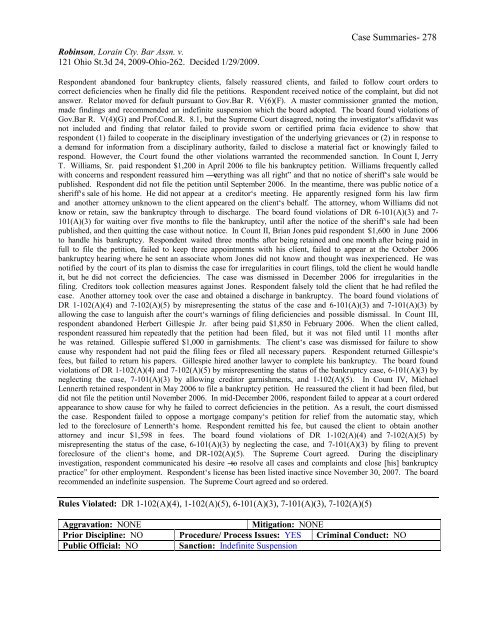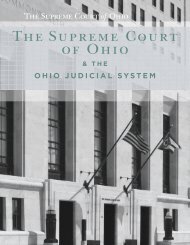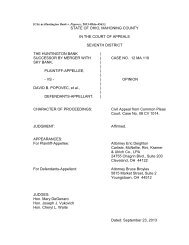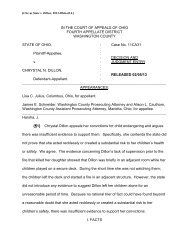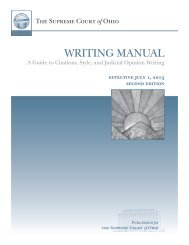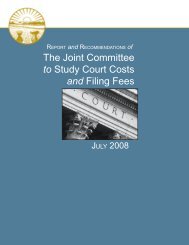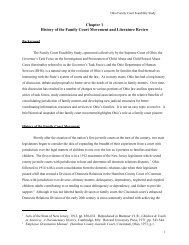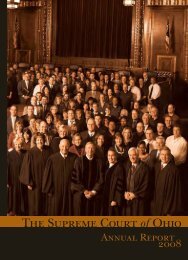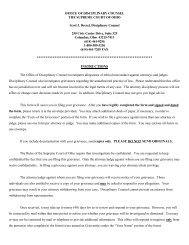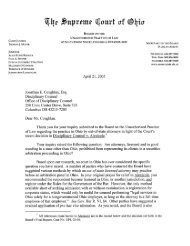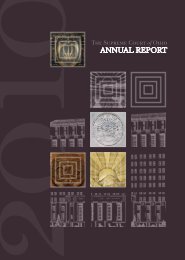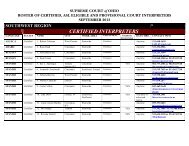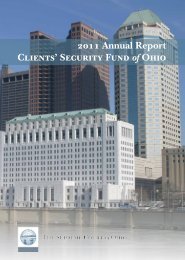disciplinary handbook: volume v - Supreme Court - State of Ohio
disciplinary handbook: volume v - Supreme Court - State of Ohio
disciplinary handbook: volume v - Supreme Court - State of Ohio
You also want an ePaper? Increase the reach of your titles
YUMPU automatically turns print PDFs into web optimized ePapers that Google loves.
Robinson, Lorain Cty. Bar Assn. v.<br />
121 <strong>Ohio</strong> St.3d 24, 2009-<strong>Ohio</strong>-262. Decided 1/29/2009.<br />
Case Summaries- 278<br />
Respondent abandoned four bankruptcy clients, falsely reassured clients, and failed to follow court orders to<br />
correct deficiencies when he finally did file the petitions. Respondent received notice <strong>of</strong> the complaint, but did not<br />
answer. Relator moved for default pursuant to Gov.Bar R. V(6)(F). A master commissioner granted the motion,<br />
made findings and recommended an indefinite suspension which the board adopted. The board found violations <strong>of</strong><br />
Gov.Bar R. V(4)(G) and Pr<strong>of</strong>.Cond.R. 8.1, but the <strong>Supreme</strong> <strong>Court</strong> disagreed, noting the investigator‘s affidavit was<br />
not included and finding that relator failed to provide sworn or certified prima facia evidence to show that<br />
respondent (1) failed to cooperate in the <strong>disciplinary</strong> investigation <strong>of</strong> the underlying grievances or (2) in response to<br />
a demand for information from a <strong>disciplinary</strong> authority, failed to disclose a material fact or knowingly failed to<br />
respond. However, the <strong>Court</strong> found the other violations warranted the recommended sanction. In Count I, Jerry<br />
T. Williams, Sr. paid respondent $1,200 in April 2006 to file his bankruptcy petition. Williams frequently called<br />
with concerns and respondent reassured him ―everything was all right‖ and that no notice <strong>of</strong> sheriff‘s sale would be<br />
published. Respondent did not file the petition until September 2006. In the meantime, there was public notice <strong>of</strong> a<br />
sheriff‘s sale <strong>of</strong> his home. He did not appear at a creditor‘s meeting. He apparently resigned form his law firm<br />
and another attorney unknown to the client appeared on the client‘s behalf. The attorney, whom Williams did not<br />
know or retain, saw the bankruptcy through to discharge. The board found violations <strong>of</strong> DR 6-101(A)(3) and 7-<br />
101(A)(3) for waiting over five months to file the bankruptcy, until after the notice <strong>of</strong> the sheriff‘s sale had been<br />
published, and then quitting the case without notice. In Count II, Brian Jones paid respondent $1,600 in June 2006<br />
to handle his bankruptcy. Respondent waited three months after being retained and one month after being paid in<br />
full to file the petition, failed to keep three appointments with his client, failed to appear at the October 2006<br />
bankruptcy hearing where he sent an associate whom Jones did not know and thought was inexperienced. He was<br />
notified by the court <strong>of</strong> its plan to dismiss the case for irregularities in court filings, told the client he would handle<br />
it, but he did not correct the deficiencies. The case was dismissed in December 2006 for irregularities in the<br />
filing. Creditors took collection measures against Jones. Respondent falsely told the client that he had refiled the<br />
case. Another attorney took over the case and obtained a discharge in bankruptcy. The board found violations <strong>of</strong><br />
DR 1-102(A)(4) and 7-102(A)(5) by misrepresenting the status <strong>of</strong> the case and 6-101(A)(3) and 7-101(A)(3) by<br />
allowing the case to languish after the court‘s warnings <strong>of</strong> filing deficiencies and possible dismissal. In Count III,<br />
respondent abandoned Herbert Gillespie Jr. after being paid $1,850 in February 2006. When the client called,<br />
respondent reassured him repeatedly that the petition had been filed, but it was not filed until 11 months after<br />
he was retained. Gillespie suffered $1,000 in garnishments. The client‘s case was dismissed for failure to show<br />
cause why respondent had not paid the filing fees or filed all necessary papers. Respondent returned Gillespie‘s<br />
fees, but failed to return his papers. Gillespie hired another lawyer to complete his bankruptcy. The board found<br />
violations <strong>of</strong> DR 1-102(A)(4) and 7-102(A)(5) by misrepresenting the status <strong>of</strong> the bankruptcy case, 6-101(A)(3) by<br />
neglecting the case, 7-101(A)(3) by allowing creditor garnishments, and 1-102(A)(5). In Count IV, Michael<br />
Lennerth retained respondent in May 2006 to file a bankruptcy petition. He reassured the client it had been filed, but<br />
did not file the petition until November 2006. In mid-December 2006, respondent failed to appear at a court ordered<br />
appearance to show cause for why he failed to correct deficiencies in the petition. As a result, the court dismissed<br />
the case. Respondent failed to oppose a mortgage company‘s petition for relief from the automatic stay, which<br />
led to the foreclosure <strong>of</strong> Lennerth‘s home. Respondent remitted his fee, but caused the client to obtain another<br />
attorney and incur $1,598 in fees. The board found violations <strong>of</strong> DR 1-102(A)(4) and 7-102(A)(5) by<br />
misrepresenting the status <strong>of</strong> the case, 6-101(A)(3) by neglecting the case, and 7-101(A)(3) by filing to prevent<br />
foreclosure <strong>of</strong> the client‘s home, and DR-102(A)(5). The <strong>Supreme</strong> <strong>Court</strong> agreed. During the <strong>disciplinary</strong><br />
investigation, respondent communicated his desire ―to resolve all cases and complaints and close [his] bankruptcy<br />
practice‖ for other employment. Respondent‘s license has been listed inactive since November 30, 2007. The board<br />
recommended an indefinite suspension. The <strong>Supreme</strong> <strong>Court</strong> agreed and so ordered.<br />
Rules Violated: DR 1-102(A)(4), 1-102(A)(5), 6-101(A)(3), 7-101(A)(3), 7-102(A)(5)<br />
Aggravation: NONE<br />
Mitigation: NONE<br />
Prior Discipline: NO Procedure/ Process Issues: YES Criminal Conduct: NO<br />
Public Official: NO Sanction: Indefinite Suspension


